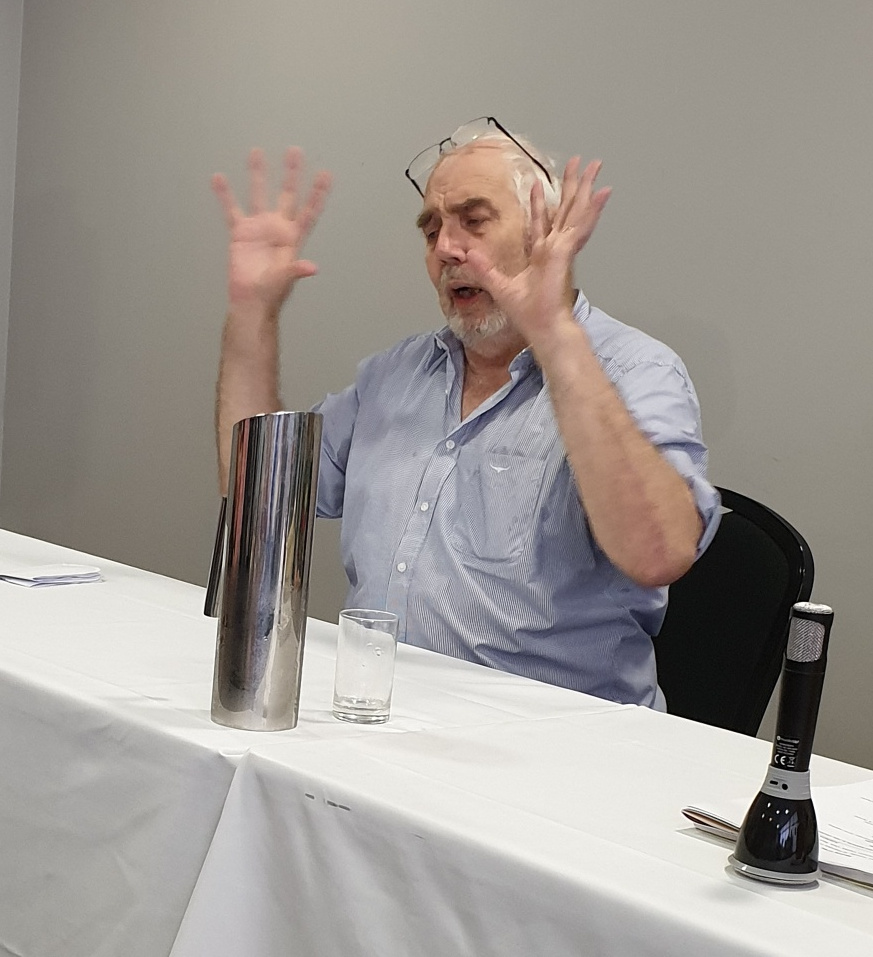“Andrew Barr and the developers – Developing away the national capital”
We welcomed Jack, former editor of the Canberra Times.
Jack explained what was happening in Canberra. Everyone over 42 is a whinger longing for a long past golden age. Under 42 people are with-it and vibrant, and they want growth and development.

These younger people are the ones Andrew Barr is in touch with via social media. His communion with these people is so wonderful that he doesn’t even need to consult them. He has a spiritual communion. When whingers moan, he ignores them. He says 1) I have a magic communion with youth and I’m right, and 2) none of you is going to vote Liberal anyway.
photo: Jack clarifies a point
So in the last election, Labor was “smug, arrogant and too comfortable”. A group of ratbags in the old “residents’ rally” could have beaten them.
Some background: Australia has a very very high standard of living, partly because we’re less unequal than some places; we have a good climate; public holidays; high wages; good reservoirs of capital; and good education. We rate ourselves especially highly on well-being.
And if we are doing well at the top, Canberra’s population of 400,000 is 20% higher again. Of course there are areas of disadvantage. But it’s possible that we live in the workers’ paradise. So where is the joy? People are unhappy about what’s going on.
Canberra was established as a model city to show us how to live affordably and healthily. Every block was sewered and powered. Public space was made generous. Fencing was less common, Our leaders encouraged trees and gardens, and wanted things to be nice. We had good architect-designed schools.
Woden and Belconnen weren’t so good. Facilities came slower than previously, but they were still planned for. Each suburb was a mini-community of its own – this was the days of the one-car family.
Both left and right sides of politics were committed to this ideal. We would be self-sustainable. Land rental income would provide services.
It was a noble experiment, but collapsed in 1970 in a by-election after Labor’s Jim Fraser (federal member for the ACT) died and John Gorton abolished land rent.
The Federal minister for finance got the idea that Australians were tired of subsidising Canberra and thus self-government arrived. We didn’t ask for it; and the federal government doesn’t pay for the buildings it occupies. This also happened at a time when we were moving away from old ideas about a benevolent social and economic system. The new ACT government decided it needed to sell land, with rationing of land intended to increase the price.
In 1975 land in the ACT was very affordable. Now it is up with the most expensive in the country and the younger generation is frozen out. Our grandchildren will have to wait until we die and leave them the land we own. They themselves will not really need it being probably past the stage of raising their own kids by then.
We have however halved the size of house blocks. Houses used to average 12 squares and now this has jumped to 20. The average Canberra household has three cars where one was the norm; and four TVs. So houses are now jammed, McMansions too big for their blocks and no back garden. Kids have to play in the street. We’re building slums. Buses don’t fit easily in some streets. The idea of Canberra as a model city has been destroyed. Other cities are starting to plan for poorer people’s housing and have surpassed what we have here. Red Hill, for example, used to have 50% social housing. The first ACT suburb with none was Hawker. Social housing has become crisis housing, and it’s crowded together rather than being interspersed.
The “ABC” social housing blocks in Reid have gone, their residents resettled in north Canberra. These blocks were worth a lot of money! What is built instead fills the inner city with yuppy individualists looking for “life style”.
The planning authorities meanwhile don’t plan but have become places to get stamps of approval. They will look at problems in development applications, but only if someone objects. Nor is nfrastructure is planned for. What we are losing is a sense of community; human scale and interaction.
Privatisation of public spaces has become a problem. Many Garema Place shops have closed down. Their landlords are landbanking. In the past, they couldn’t do this.
Around the Boulevard, there is very little activity. The “City to the Lake” project has not led to economic activity in the Boulevard area. There are fears that the lake is a cheap land grab for private developers to sell to yuppies. Almost every deal looks like a get-rich-quick deal. Then the Manuka oval proposal, Tony Shepherd & co. (part of the committee that advised Tony Abbott on how to cut public spending). The entire ACT government loved his deal and were only restrained by the sharp public reaction against it.
$120 million is given to top-notch for-profit sports clubs, with not a lot of investment in smaller-level sport. But Canberrans go to art or flower shows as much as sport. We go to lots of plays. But the ACT government is not investing there.
Note that there isn’t much sports rorting here! Corruption in trade union land deals? Not necessarily, but we have a new model of trade union, which works for union members and is also a land owner, investor and developer, to the point where one aspect must shrink. Can you be an arsehole developer and not rip off workers?
Jack spoke further on these themes but this note-taker can’t read their scribbled notes well enough to put more of his thoughts to the page. Read him elsewhere! He has many platforms.
